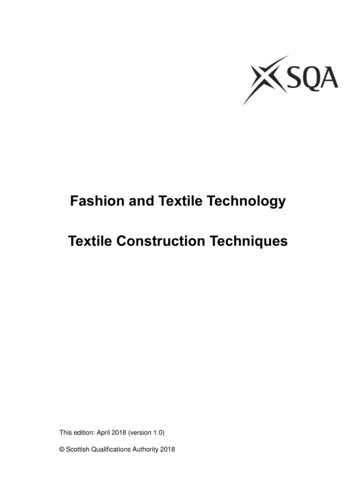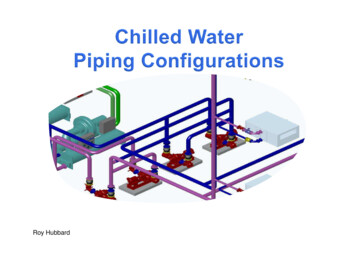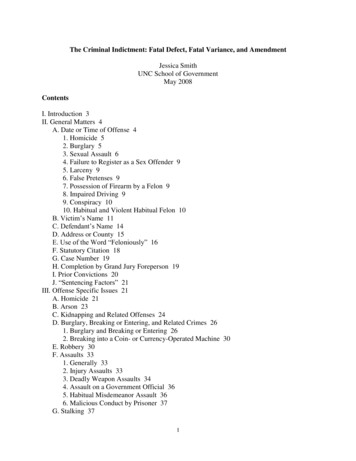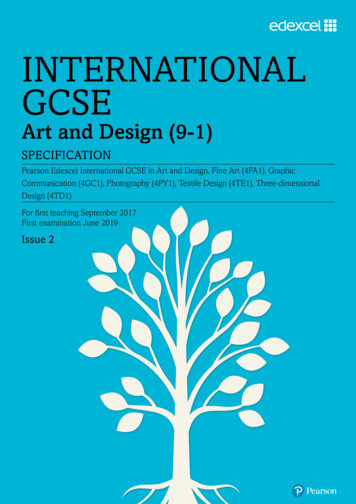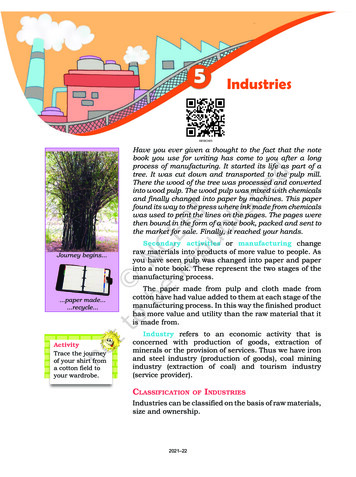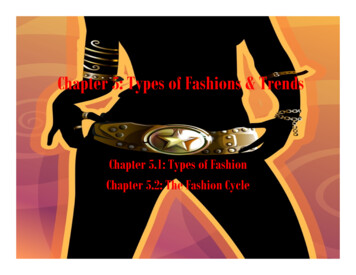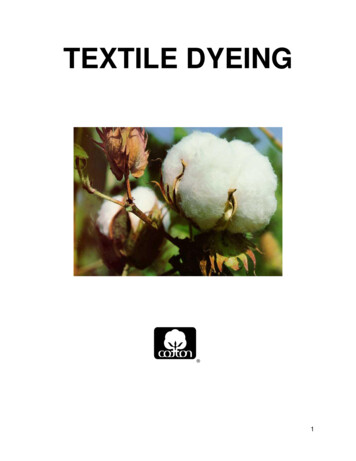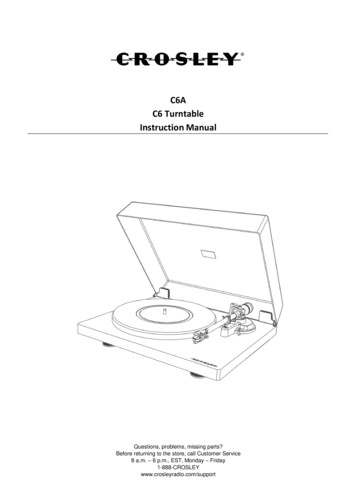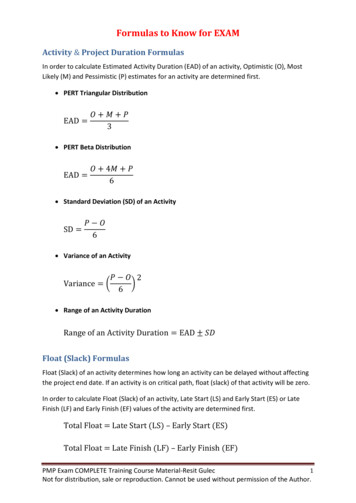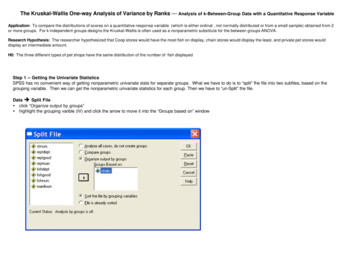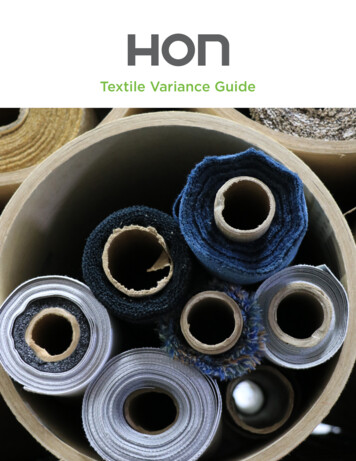
Transcription
Textile Variance Guide
Table of ContentsIntroduction3Expectations Performance & AestheticsColor Fastness4Stitching Techniques4Pattern vs. Railroad4Double-Rub Disclaimer4Leather Variance5Wool5Welt Cords5COM Fabrics6COM Textile Release6SeatingAdditional Seams Required7Stitch Tracks7Thread Separation7Thick, Thin, and Stiff Fabrics7Material Stretch and Set8Two-Way Patterns8Large Pattern Repeat8Normal Stitch Process Not Used9Material Fray9Material Roll Width9Glue Release9Fabric Backing and Finishing10PanelsLinearity Tolerance11Pattern Match-up11Material Fray11Natural Fiber Content11Glue Release12Surface Defects Visible12Textile Variance 2
IntroductionHON offers a wide variety of material types and options for protecting and applying them. Thisguide will walk you through the process of selecting materials – giving you an introduction to thebasic information and industry nomenclature to help you make the right choices. Before making afinal decision on any material, be sure to read through this entire guide to understand any qualityconcerns and the COM approval process overall. For more details, visit honready.hon.comIf you have any questions, don’t hesitate to contact our Tailored Products Coordinator, who willrespond within 24-48 hours:HONCOMTeam@honcompany.com800.833.3964, Option 4In some cases, a waiver may be required for approval. If you are comfortable with the possibilityof a defect and would like to continue with a selected fabric, please contact our Tailored ProductsCoordinator to complete and sign the waiver form.Textile Variance 3
Expectations Performance & AestheticsCOLOR FASTNESSColor fastness to light ratings are only based on 40 hours of exposure. Extended exposure to direct sunlight over timewill cause visible fading in all textiles not specifically designed for outdoor application. Always avoid placing textiles inareas of constant or direct sunlight for extended periods of time.STITCHING TECHNIQUESThere are several sewing stitch types that can be used onupholstered products. The most common stitch type used insewing upholstery is the top stitch. There are two types of topstitches: the single needle and the double needle. Some of ourproducts use no top stitch. In these products, two pieces of fabricare sewn together without fold-over. This can create concern forcertain fabrics as seams can pull if the material has too little ortoo much stretch. For these applications, additional seams or adifferent stitch type is required. When upholstering a product inleather, a saddle stitch is used. With a saddle stitch, both needlesenter through top and bottom holes when sewn. The saddlestitch is like a back stitch in terms of strength and is therefore theoptimal stitch for leather textiles.Top StitchPATTERN VS. RAILROADPATTERN – Up the rollRAILROAD – Across the rollThe application orientation of fabric plays a large role in the overall aesthetic of a finished product. Fabric suppliers willoften note the orientation of fabric shown on their website. Some of our products can only be oriented in one directiondue to material width constraints. For products like these, your COM test response will say “railroad only,” meaning forthis specific product the fabric must be applied in the horizontal direction or extra seams will be required.For panel systems, application direction can also be restricted based on product size. Because some fabrics are only 54”wide, they can only be applied in pattern orientation on panels less than 48” wide and in railroad orientation on panelsless than 48” tall. For instances like this, your COM test response will say “width pass,” meaning the fabric width is toonarrow for certain product sizes.DOUBLE-RUB DISCLAIMERThe standard measurement for textile durability in the contract furniture market has always been double-rub values.Recently, however, the Association for Contract Textiles (ACT) and its partners have been investigating how accuratelythese values represent the longevity of a textile material. Studies have shown that “A variance of at least 60 percentwas observed in a 2009 ACT Wyzenbeek Performance Verification Fabric Study.” ACT states that “Multiple factorsaffect fabric durability and appearance retention, including end-user application and proper maintenance. Wyzenbeekresults above 100,000 double rubs have not been shown to be an indicator of increased lifespan. Double rubs exceeding100,000 are not meaningful in providing additional value in use and not predictive of significant extension of a fabric’sservice life.” Additionally, ACT notes “A fabric with twice the number of abrasion cycles does not indicate double theservice life.” This is not to say abrasion values should not be trusted. However, one should be aware that they are not theultimate determination of textile durability.Textile Variance 4
(Expectations Continued)LEATHER VARIANCELeather VarianceLeather is one of the most unique textiles because it comes fromthe hide of a once living animal. The life experiences of eachindividual animal greatly affect the characteristics and visualappearance of each leather hide. Due to this, the quantity andseverity of visual scarring and color variation can vary from hide tohide and should be expected for some leathers within our offering.The level of textile processing determines the quantity of naturalcharacteristics and level of visual variation that can be expectedfrom hide to hide. It is important to note that the presence ofnatural characteristics is not a direct indication of poor quality ordefective material.WOOLWool is a natural staple fiber that comes from the fur of animals.Wool yarn is constructed by twisting hundreds to thousands ofwool fibers around one another. This is what gives wool its naturallook and feel.WoolThere are two types of wool: worsted and woolen. Worsted wooluses extra twists in processing to keep the wool fibers from pilling,which creates a slicker feel. Woolen wool is the common “hairier”wool that has the classic texture associated with most woolfabrics. Woolen wool fabric often releases excess fibrous materialduring production, but over time these fibers will release fromthe material without affecting the quality of the material. This ispart of the natural aesthetic and hand of woolen yarns due to thelooser-wrapped fibers releasing from the yarn and creating thenatural “fuzzy” look of woolen fabrics.WELT CORDSA welt cord is a cable or string wrapped in a textile material thatis used for aesthetics on the outer edge of seating upholstery.Welt cords can exaggerate certain properties within a textile thatare not aesthetically pleasing. This is most common in pile fabricswhere the individual yarns will stick out in varying directions. It isimportant to always consider final aesthetic when specifying weltcord materials.Welt CordsTextile Variance 5
(Expectations Continued)COM FABRICSThe HON Company cannot guarantee that a COM will meet the same performance durability requirements as a HONbranded or partnership fabric. It is for this reason that COM specified materials are not covered under warranty. Extracare should be taken when specifying a COM fabric in understanding the end use requirements to ensure the productwill hold up over time.Please consider the following before specifying COM fabrics on your product:1. Abrasion requirementsa. 30,000 or above is recommended for average use environmentsb. 50,000 or above is recommended for high traffic environments2. Stain repellency3. Material Contenta. Woven fabrics with high cotton or nylon content can experience poor recovery leading to fabric puddlingb. Polyurethane coated fabrics made of low grade materials can experience poor recovery leading to fabricpuddlingCOM TEXTILE RELEASEIf a requested COM has failed or passed conditionally, a COM Textile Release can be signed. A COM Textile Releaseallows a customer to use a COM that has failed on a product by accepting and agreeing to the possibility of an aestheticvariation being present. The aesthetic variation can be, but is not limited to, the fail status provided on the COMresponse email. With a COM Textile Release, the customer accepts that the final product may have a varying degree ofthe aesthetic variation present and that the performance and durability of the material may be affected. HON reservesthe right to deny any COM Textile Release request for textiles that cannot be upholstered in the requested applicationto any degree of acceptable quality. A COM Textile Release Request must be submitted for every install location utilizingthe requested textile. For a COM Release Order Code to be used, there must be a signed COM Textile Release associatedwith the specific order and install location. COM Textile Release forms are only available for COM textiles and cannot beapplied to HON standard or partnership textiles.Textile Variance 6
SeatingADDITIONAL SEAMS REQUIREDCOM TEST RESPONSE: ADDITIONAL SEAM/SEAMS REQUIREDWhen applying fabrics on certain products, additional seams maybe required. For larger lounge seating products, normal upholsteryis not wide enough to cover the entire unit and additional seamsare required. Seams are also used to decrease surface defects(puckers and wrinkles) on products with deep curvatures. Becausethe addition of seams can change the overall aesthetic, it is alwaysadvisable to obtain a rendering of the product before movingforward with additional seams.Additional Seams RequiredSTITCH TRACKSCOM TEST RESPONSE: STITCH TRACKS“Stitch tracks” is the term upholstery experts use when the yarn ofa fabric separates or a background yarn is brought to the surfacethrough sewing. Stitch tracks are seen more frequently in productsthat do not use a top stitch in all areas. This effect is more commonin fabrics that have high contrasting colors. Fabrics that havelooser construction or do not have a backer tend to experiencethis phenomenon more frequently. If you would like to considerthe addition of a backer to your fabric, please consult our COMdepartment for changes to lead time and pricing.THREAD SEPARATIONCOM TEST RESPONSE: FRAYING PULLS APART RIPSFabrics constructed in a looser weave or using thicker yarns tendto unravel and separate when cut and experience surface defectswhen sewn together. When cut, the yarns will release and untangle,causing fabric fray and material loss. These fabrics will also pullapart or rupture under normal stresses and expose seam stitchingand needle holes, or even separate entirely. In certain cases, addinga fabric backer can help solve these issues. If you would like toconsider the addition of a backer to your fabric, please consult ourCOM department for changes to lead time and pricing.Cat Tracks & Thread SeparationTHICK, THIN AND STIFF FABRICSCOM TEST RESPONSE: MATERIAL TOO THICK/MATERIAL TOO THINFor certain products, fabrics that are too thick, thin or stiff cannot be applied without visual defects. Fabrics that are toostiff can bridge across deep curvatures, causing the fabric to “trampoline” or create a gap between the foam and fabric.Fabrics that are too thin can wrinkle around seat and back edges. These wrinkles are often very difficult to remove throughconventional processes and can return over time. Fabrics that are too thick often bunch around tight corners or show toomuch selvage material creating an uneven surface. These materials are not recommended for pieces with square corners orsharp edges.Textile Variance 7
(Seating Continued)MATERIAL STRETCH AND SETCOM TEST RESPONSE: EXCESSIVE STRETCHCertain materials suffer from what is known as stretch and set. Amaterial that is stretched beyond its normal length consistentlyover a period of time will never fully retract back to its originalshape. This is what causes coated fabric upholstery in high-trafficareas to wrinkle and puddle over time. Not all coated materialssuffer from this issue at the same rate. We recommend seekingdirection from your dealer on the best fabrics for high-trafficapplications.Material Stretch and SetTWO-WAY PATTERNSCOM TEST RESPONSE: TWO-WAY PATTERNNumerous fabrics have geometric patterns that run bothhorizontally and vertically. With some of our lounge seatingproducts as an example, these patterns can create a less-thandesirable aesthetic where the patterns clash.LARGE PATTERN REPEATCOM TEST RESPONSE: LARGE REPEATSome fabrics have patterns with very large repeats, which can bedifficult to fully represent on smaller products. Additionally, thesame section of the repeat may not be represented on every partof the product or consistently from product to product. In panelsystem applications, large repeats create difficulty in maintainingconsistency across all panels.Pattern Match-upTextile Variance 8
(Seating Continued)NORMAL STITCH PROCESS NOT USEDCOM TEST RESPONSE: NORMAL STITCH PROCESS NOT USEDEach stitch type has a unique aesthetic that can alter the look of a finished product. Depending on the type of fabric andselected application, an alternative stitch type may be used to combat upholstery problems. Most commonly, alteringthe normal stitch process entails sewing in a different direction or the addition or removal of a top stitch. In most casesthe aesthetic difference will hardly be noticeable. If you would like to continue with the selected fabric without the use ofan alternative stitch process, please complete and sign the waiver form linked on the COM website.MATERIAL FRAYCOM TEST RESPONSE: FRAYING PULLS APART RIPSMaterials with a loose construction may experience fibersuntangling from the fabric. These fabrics have difficultymaintaining strength in applications with sharp corners andsevere edges. These fabrics tend to fray and will pull apart and ripdue to usage over time caused by the weakening of upholsteryseams that is not seen at the time of production. The addition of abacker is suggested for these fabrics. If you would like to considerthe addition of a backer to your fabric, please consult our COMdepartment for changes to lead time and pricing.Material FrayMATERIAL ROLL WIDTHCOM TEST RESPONSE: ROLL WIDTH TOO LARGEThe width of your chosen fabric influences which products it can be used on. For seating applications, fabrics musthave a width between 54”-61”. For panel applications, fabrics must have a width between 54”-66”. Seating fabrics witha width of less than 66” can only be applied in certain applications based on size and direction. For further informationregarding product availability by width, please review the Pattern vs. Railroad section on page 4.Due to capability constraints, we cannot override this response with a waiver form.GLUE RELEASECOM TEST RESPONSE: GLUE TESTSome products require the use of an adhesive for upholstery application. Fabrics with certain finishes and backersoccasionally have difficulty adhering to the product. Finishes and backers designed to repel and release surfacechemicals can prevent adhesives from adhering to the fabric. Coated fabrics have difficulty with heat-activated,adhesive-based upholstery methods. Coated fabrics with surface texturing cannot be used with heat-activated adhesivesas the processing can remove or damage the texturing. Thin fabrics have issues with visible surface defects whenupholstered using adhesives – as glue can seep through the material or raised edges, or concentrated glue will show onthe surface. If you would like to consider adding a backer to your fabric, please consult our COM department for changesto lead time and pricing.Textile Variance 9
(Seating Continued)FABRIC BACKING AND FINISHINGFabric BackingCOM TEST RESPONSE: BACKER REQUIREDIn today’s market, there are a variety of backers and finishesthat can be applied to textiles to improve performance. Atextile backer can be the alteration of the back of a materialthrough mechanical means such as needle punching, orchemical additives such as latex or acrylic. Textile backers canact to reduce fraying and pull-apart and can increase stretch,malleability, durability, and dimensional stability, all which aidin allowing a fabric to be upholstered; however, textile backerscan also cause problems with upholstering some products asthey can limit glue adhesion. Textile backers are not appliedto all textiles but can be applied with extended lead times andadditional cost. This is also true for textile finishes. Finishes actto impart additional performance characteristics to a textilethrough chemical additives. Commonly applied textile finishesinclude stain repellency, moisture barrier, and antimicrobial.Textile finishes can cause some textiles to become stiffer andheavier which can limit their ability to be upholstered on someproducts. Always consult a designer or member of the Colors,Materials & Finishes team before requesting the addition of afinish or backing to a textile.Textile Variance 10
PanelsLINEARITY TOLERANCECOM TEST RESPONSE: LINEARITY TOLERANCEIn vertical applications, such as panel systems, the linearity ofa fabric pattern can drastically alter the final aesthetic of theproduct and the entire space. Patterns that run linearly acrosstheir length can exhibit a “smiling” effect, or a gradual increasein the degree of pattern curvature across the panel. Thisdisrupts the flow of the pattern from panel to panel. Also, thepattern may not match up perfectly from one panel to another,causing disruption in the patterning across all panels. Avoidinglinear patterns is suggested for vertical applications.Linearity TolerancePATTERN MATCHUPCOM TEST RESPONSE: PATTERN MATCHUP NOT GUARANTEEDHON does not guarantee pattern matching on products. This includes pattern matching from panel to panel in verticalapplications. Patterns are not guaranteed to line up when placed next to each other or have any part of the pattern inthe same location. Pattern positioning is not guaranteed to be consistent across the pieces of a single product or fromproduct to product.MATERIAL FRAYCOM TEST RESPONSE: FRAYING PULLS APART RIPSMaterials with a loose construction may experience fibersuntangling from the fabric. These fabrics have difficultymaintaining strength in vertical panel applications as thematerial will release from the corners of the panel over time.These fabrics also tend to fray on the edges and corners andrip away from the panel. The addition of a backer is suggestedfor these fabrics.Material FrayNATURAL FIBER CONTENTCOM TEST RESPONSE: NATURAL FIBER CONTENTFabrics with a material content containing greater than 30% natural fiber (cotton or wool) cannot be approved forvertical panel applications. These fabrics are not guaranteed to pass the OSHA-required UL flame testing.Due to OSHA requirements, we cannot override this response with a waiver form.Textile Variance 11
(Panels Continued)GLUE RELEASECOM TEST RESPONSE: GLUE RELEASEIn vertical panel applications, certain fabrics have difficultymaintaining proper glue adhesion over time. This is mostcommon in fabrics with problematic backers, or fabrics thatare thick or heavy or have content containing Olefin yarns.Certain backers limit glue adhesion and will cause the materialto release over time. The natural weight of thick or heavymaterials will cause the glue to fail and the fabric to pull awayfrom the substrate. Olefin yarns are smooth and can repel gluerather than adhering to it.Glue ReleaseSURFACE DEFECTS VISIBLECOM TEST RESPONSE: SURFACE DEFECTSIn vertical panel applications, certain fabrics will show surfacedefects more readily than others. This is most common forlight-colored and thin fabrics. For some light-colored fabrics,the background substrate materials will show through to thesurface. For thin fabrics, the background substrate materialswill create raised areas randomly throughout the surface.In certain cases, the addition of a backer can reduce thesedefects. If you would like to consider the addition of a backerto your fabric, please consult our COM department forchanges to lead time and pricing.Surface DefectsTextile Variance 12
The HON Company200 Oak Street, Muscatine, IA 52761800.833.3964 hon.com 2019 The HON Company (1/19)To view the registered and unregistered trademarksowned and used by The HON Company, visithon.com/protected-marks. Models, upholstery andfinishes are subject to change without notice.
There are several sewing stitch types that can be used on upholstered products. The most common stitch type used in sewing upholstery is the top stitch. There are two types of top stitches: the single needle and the double needle. Some of our products use no top stitch. In these products,
